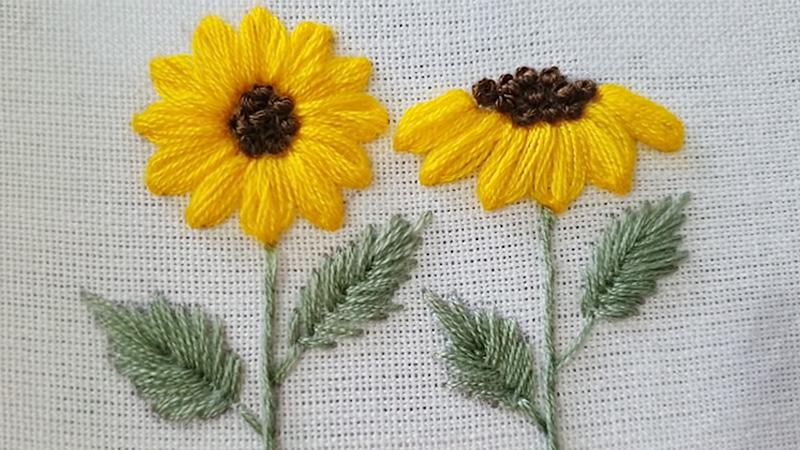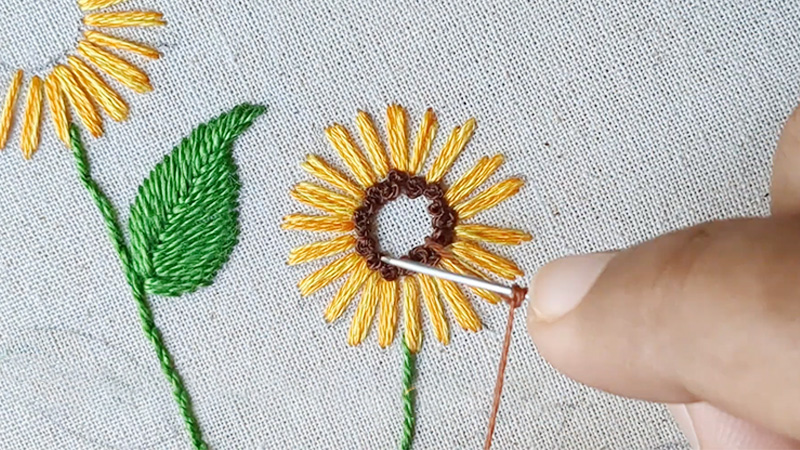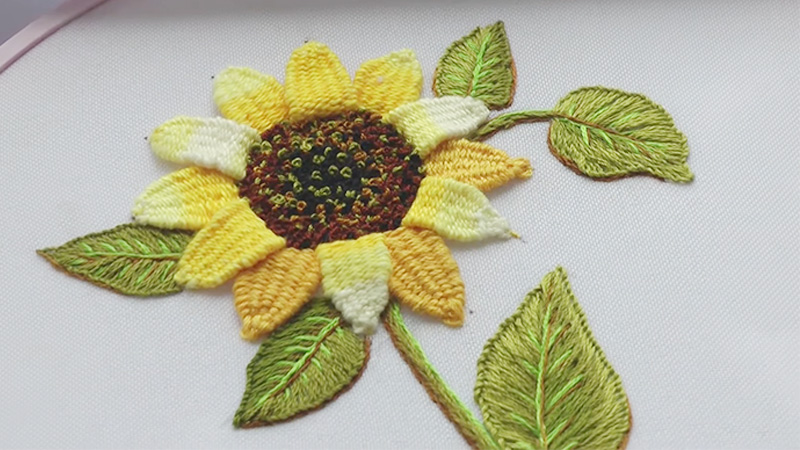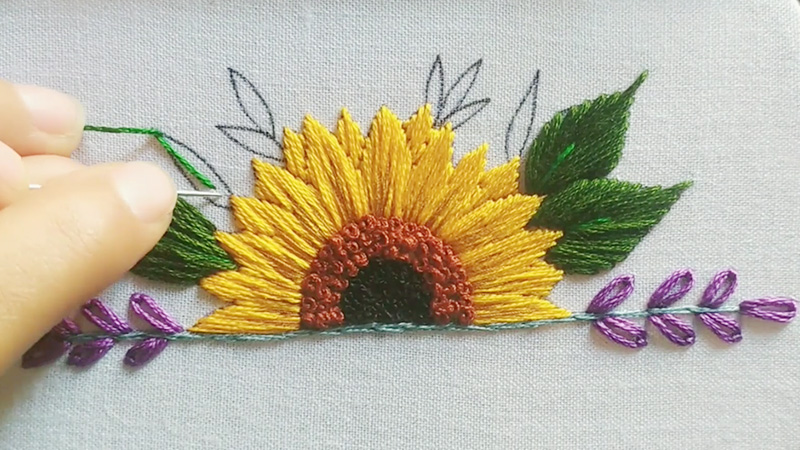Embroidery is an art form that allows you to bring beauty and vibrancy to fabric through the magic of needle and thread. The sunflower, with its warm and cheerful presence, is the perfect subject for this creative endeavor.
In this tutorial, we’ll delve into the world of embroidery and explore how to embroider a sunflower design that will brighten up any fabric or project.
Whether you’re a seasoned embroidery enthusiast or a complete beginner, this guide will take you through each step of the process, from selecting the right materials to mastering essential embroidery stitches.
By the end, you’ll not only have beautiful sunflower embroidery but also newfound skills and confidence in this timeless craft.
So, grab your embroidery hoop, threads, and a piece of fabric, and let’s embark on this artistic journey to create a sunflower that will bloom forever on your chosen canvas.

How to Embroider a Sunflower?
Embroidering a sunflower is a delightful and creative project that allows you to bring the beauty of this iconic flower to life on fabric. In this comprehensive guide, we’ll walk you through the steps to embroider a sunflower from start to finish.
Materials You’ll Need
Before you begin, gather the following materials. Choose a fabric of your preference. Cotton or linen work well for beginners. The embroidery hoop holds the fabric taut while you work, making embroidery easier.
Select thread colors for the sunflower, typical shades of yellow, brown, and green. Use needles with a large enough eye to thread your embroidery floss.
Sharp scissors for cutting the floss and fabric. You can find sunflower embroidery patterns online or draw your own on tracing paper.
Prepare Your Fabric
Begin by cutting your fabric into a size that fits comfortably within your embroidery hoop. It’s essential to start with clean, dry, and wrinkle-free fabric that’s easy to work with.
Secure the Fabric in the Hoop
Separate the two rings of your embroidery hoop. Lay your fabric over the smaller ring and place the larger ring on top, gently pushing it down until the fabric is taut. Tighten the screw to secure it in place.
Transfer Your Pattern
If you have a pattern, transfer it onto the fabric. You can use a water-soluble fabric pen, or carbon paper, or simply trace the design by holding it against a window. Ensure your design is centered and positioned where you want your sunflower to be.
Thread Your Needle
Embroidery floss is made up of multiple strands. For sunflower petals, you’ll usually use 2-3 strands at a time. Separate the desired number of strands from the floss and thread your needle. Knot the end.
Start with the Center
Begin with the center of your sunflower, typically a brown or black shade. Use a satin stitch or a combination of long and short stitches to fill in the center. You can also add some French knots for texture.
Embroider the Petals

Now, let’s move on to the vibrant petals. Use a bright yellow thread for this part. The satin stitch is commonly used for petals. Here’s how to do it.
Bring your needle up from the back of the fabric to the front at the base of a petal. Insert the needle down into the fabric near the tip of the petal, creating a straight stitch.
Repeat this process, spacing your stitches close together along the petal’s outline. Continue filling in each petal until you’ve completed the flower’s outer layer.
Add Detail with Backstitch
To add dimension and detail to your sunflower, you can use a backstitch for the petal outlines. It’s a simple, yet effective, stitch. Bring the needle up at the base of a petal. Insert it back down a short distance away, creating a straight stitch.
Bring the needle up again, slightly in front of the previous stitch, and insert it back down in the same line. Continue this process along the outline of each petal.
Create the Sunflower’s Stem and Leaves
Switch to a green thread for the stem and leaves. Use a backstitch to outline the stem, and then fill it in with long satin stitches. For the leaves, use a combination of satin stitches and long and short stitches to give them a natural appearance.
Finish with Details
To add realism, consider adding some French knots or seed stitches to the center and around the petals. These stitches create texture and depth.
Once you’ve completed your embroidery, flip the hoop over and carefully trim any excess thread. Make sure all knots are secure.
Remove from Hoop
Loosen the screw on your embroidery hoop and gently remove your fabric from it. Trim any excess fabric around the edges.
You can frame your finished sunflower embroidery in a hoop or a traditional picture frame, showcasing your beautiful creation.
Congratulations! You’ve successfully embroidered a vibrant sunflower. Remember, practice makes perfect, so don’t be discouraged if your first attempt isn’t flawless.
With time and patience, your embroidery skills will improve, allowing you to create even more intricate and stunning designs. Happy stitching!
Common Patterns to Embroider a Sunflower

Embroidering a sunflower offers a wide range of creative possibilities. Here are some common patterns and techniques you can use to embroider a sunflower:
Simple Sunflower
This is a classic sunflower design with a large, round center and bold, yellow petals. You can use satin stitches to fill in the petals and add dimension with backstitches for petal outlines.
Sunflower Bouquet
Create a bouquet of sunflowers with varying sizes and stages of bloom. This design adds complexity and visual interest to your embroidery. Include the sunflower’s lush green leaves to make your design more vibrant and realistic. Use different shades of green for the leaves and stems.
Sunflower and Bees
Add a touch of nature to your embroidery by including buzzing bees among the sunflowers. Bees can be embroidered using small, repetitive stitches, and you can even use metallic thread for a shimmering effect.
Sunflower in a Vase
Embroider a vase or pot with a sunflower arrangement. This pattern allows you to explore different vase shapes and textures. Experiment with abstract or geometric sunflower designs. These can be contemporary and unique, using a variety of stitches and shapes.
Sunflower Wreath
Create a circular sunflower wreath by arranging sunflowers in a circle, with or without leaves and other floral elements. This is a charming design for framing or displaying.
Sunflower Field
If you want to embark on a larger project, consider embroidering a sunflower field. This pattern involves multiple sunflowers scattered across the fabric, offering a beautiful, natural scene.
Add a cute ladybug crawling on one of the sunflower petals for an adorable touch. Ladybugs can be embroidered with tiny French knots for their spots.
Sunflower Border
Create a sunflower border pattern that you can use to embellish the edges of linens, tablecloths, or other fabric items. Repeat the sunflower and leaf motifs in a continuous pattern.
Watercolor Sunflower
Emulate the look of a watercolor painting by using blending and shading techniques with embroidery floss. This approach gives your sunflower a soft, artistic appearance.
Sunflower Mandala
Combine the concept of a mandala with the sunflower’s circular shape. This intricate design can incorporate various stitches and colors to create a mesmerizing sunflower mandala.
Remember that these patterns are just starting points for your creativity. Feel free to mix and match techniques, colors, and stitches to create a sunflower embroidery that’s uniquely your own.
Whether you’re a beginner or an experienced embroiderer, there’s a sunflower design that can suit your skill level and artistic preferences.
What Stitches to Embroider a Sunflower?

Embroidering a sunflower can involve a variety of stitches to create different textures and details. Here are some common embroidery stitches you can use to embroider a sunflower:
Satin Stitch and Backstitch
Satin stitches are often used to fill in the petals of a sunflower. They create a smooth and shiny surface, resembling the texture of sunflower petals. You can use varying shades of yellow for a more realistic effect.
Backstitch is great for outlining the petals, leaves, and stems of the sunflower. It creates a crisp, continuous line that defines the edges of these elements.
French Knots
French knots work well for adding texture to the sunflower’s center. They can mimic the tiny seeds found in the sunflower’s disk. Create clusters of French knots for a more realistic look.
Long and Short Stitches
Long and short stitches are often used for shading and blending colors in sunflowers. This stitch allows you to create a gradation of colors, making the petals appear more natural.
Chain Stitch
Chain stitches can be used to create a decorative border around the sunflower or to add a layered effect to the petals and leaves. You can use a chain stitch to add extra texture to the design.
Split Stitch and Seed Stitch
Split stitch can be used for outlining and adding detail to the sunflower. It creates a delicate, textured line that can be perfect for creating depth and dimension.
Seed stitch can be used for the sunflower’s center or for creating a speckled effect on the petals. It involves small, random stitches that resemble seeds or small dots.
Running Stitch and Bullion Knots
Running stitches can be used for background texture or to create subtle lines on the petals. They are quick and easy to work and can add interest to the design.
Bullion knots can be used to add texture and dimension to the sunflower’s center, creating a raised and textured effect.
Stem Stitch
Stem stitch is ideal for creating the sunflower’s stem. It creates a smooth, rope-like line that looks natural for plant stems. When embroidering a sunflower, you can use a combination of these stitches to achieve the desired texture and visual effect.
Experiment with different stitches and colors to make your sunflower embroidery unique and vibrant. Additionally, don’t hesitate to adapt these stitches based on your artistic preferences and the level of detail you want to achieve in your design.
FAQs
What type of fabric is best for embroidering a sunflower?
For embroidering a sunflower, it’s best to choose a fabric like cotton or linen. These fabrics provide a stable and even surface for embroidery, making it easier to work on intricate details.
How do I transfer a sunflower embroidery pattern onto my fabric?
You can transfer a sunflower embroidery pattern to your fabric using various methods. One common method is to use a water-soluble fabric pen or pencil to trace the design directly onto the fabric.
What thread colors should I use for embroidering a sunflower?
Typically, you’ll need shades of yellow, brown, and green embroidery floss for a sunflower. Yellow is for the petals, brown or black for the center, and green for the stem and leaves.
Depending on your desired level of detail and shading, you may also use different shades.
Can I embroider a sunflower if I’m a beginner at embroidery?
Yes, you can definitely embroider a sunflower as a beginner. Sunflowers are a great choice for beginners because they often involve simple stitches like satin stitch, backstitch, and French knots.
How can I prevent my fabric from puckering while embroidering a sunflower?
To prevent fabric puckering, make sure your fabric is stretched taut in the embroidery hoop. Avoid pulling your stitches too tightly, as this can distort the fabric.
Additionally, you can use an embroidery stabilizer or backing fabric to provide extra support and prevent puckering.
Conclusion
Embroidering a sunflower is not just about creating a beautiful piece of art; it’s a therapeutic and fulfilling experience that allows you to express your creativity.
Throughout this guide, we’ve covered the fundamentals of sunflower embroidery, from selecting the right materials to mastering various stitches like satin stitch, backstitch, and French knots.
As you finish your sunflower embroidery, take a moment to admire the intricate details and the effort you’ve put into it. Remember that practice makes perfect, so don’t be discouraged if your first attempt isn’t flawless.
Now that you’ve completed this project, consider applying your newfound knowledge to other floral designs or creating your own unique embroidery patterns.
So, keep your needle threaded and your creativity flowing, and may your future embroidery projects bloom with the same radiance as the sunflower you’ve crafted. Happy stitching!
Leave a Reply